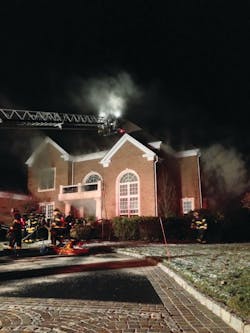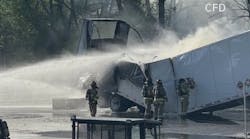This month’s Close Call is one that is near and dear to me, as not only did it involve some close and longtime friends, but involved a department to which I owe a great deal of gratitude, as I essentially started my career with this organization in the early 1970s. While I am no longer an “active” member of this department, I do hold associate membership status in Company No. 3, something of which I am extremely proud.
The Manhasset-Lakeville Fire Department (M-LFD) is on the border of New York City’s borough of Queens, in Nassau County, Long Island, NY. The response area covers 10 square miles with a residential population of 50,000 that grows to more than three times that number during the work week. Within the district are two major hospitals, an industrial park, three high schools, seven middle and elementary schools, numerous shopping centers, an interstate highway and a state parkway, the largest commuter railroad in the U.S. and many houses of worship, office buildings and light industrial/commercial occupancies. The department also covers more than two miles of shorefront along Long Island Sound.
M-LFD averages 3,000 incidents annually, including more than 1,300 house or structure responses and 900 ambulance calls (EMS transport is provided jointly by M-LFD and Nassau County Police EMS) and various other emergencies, including brushfires, downed electrical wires and vehicle fires. This number also includes motor vehicle accidents, which at times required the use of the fire department’s heavy rescue units. Nassau County’s fire service is broken into nine geographical battalions, and M-LFD is part of the 8th Battalion.
A 100% volunteer organization, there are more than 250 active members within the five fire companies and one EMS company at M-LFD. A company, as defined by M-LFD, is a firehouse led by a captain and two lieutenants, each providing engine company service as well as special services:
• Company 1 – Two engines and a technical rescue covering the Manhasset area
• Company 2 – A truck and an engine covering the Manhasset Valley
• Company 3 – A heavy rescue and two engines covering the Great Neck-Thomaston area
• Company 4 – Two trucks (tower ladder and aerial ladder) and an engine covering the Great Neck-Lakeville area)
• Company 5 – Two engines and a squad (a squad is an engine company with rescue services equipment) covering the North New Hyde Park area
• Company 6 – Two ALS transport ambulances and an ALS non-transport SUV (Company 6 shares the quarters of Rescue Company 3)
The department is tax funded by the Manhasset-Lakeville Fire District, led by three publicly elected fire commissioners who also oversee the Manhasset-Lakeville Water District. To support the department, the district has full-time equipment, building and apparatus maintenance personnel, many whom are also volunteer firefighters. The district also provides full-time professional fire/EMS dispatch service.
Our sincere thanks to M-LFD Chief of Department Christopher Pisani and Deputy Chiefs Kirk Candan, Michael Farrone, Scott Garrigan and Mark Kiess for their assistance in sharing this report. Additional thanks to Lieutenant Sean Dolan, Firefighter John McCann, Lieutenant Lee Genser, EMT Tracey Dolan, Fire Commissioners Donald T. O’Brien, Andrew J. DeMartin and Brian J. Morris as well as all the members and mutual aid departments who responded to this incident.
Before we go further, I want to share a quote that’s always stuck with me from reading the book Fireground Tactics by Chief Emanuel “Manny” Fried, published back in 1972. Fried was a former FDNY battalion chief (44 Battalion during the “war years”) as well as chief of department in Chicago Heights and Hinsdale, IL.
Chief Bill Clark (former FDNY battalion chief, Prince George’s County, MD, fire director and Florida State Fire College director) wrote the foreword to Fried’s book. In it, he thanks Chief Fried for saving their and several other firefighters’ lives – not by way of a heroic grab, but one of a tactical command decision by pulling them out prior to their certain death. This close call at the M-LFD immediately reminded me of Chief Clark’s comment about the actions taken by his friend, Chief Manny Fried, in saving lives. Clearly, the M-LFD officers and members operating on that scene saw the warning signs – for a variety of reasons – and took immediate measures to get their members out in time.
On Jan. 18, 2014, M-LFD was alerted to respond to a reported fire in a dwelling. What happened there is a lesson for all of us, especially when responding to lightweight wood construction.
The following account is from Chief of Department Christopher Pisani, who was the incident commander at this fire:
On Saturday, Jan. 18, at 8:05 P.M., we received a call for a reported house fire at 32 Stone Hill Drive South. Companies 1, 2, 3 and 6 were dispatched (normal response for a verbally reported structure fire). It was a cold, snowy evening. I (87-02) arrived at 8:10, followed by Deputy Chiefs Candan, Kiess and Farrone. Engine 87-40 was not on the initial dispatch, but it had a crew in quarters, so I told them to respond; that unit arrived at 8:13. Engine 87-35 arrived at 8:13 and Engine 87-11 at 8:14.
Our dispatch center, 870, advised me of a reported house fire (one telephone call). While enroute, 870 advised me of a second call for a fire as well as the automatic alarm for the residence. Additionally, Nassau County police arrived on scene requesting the fire department to “step it up.” Upon receiving this information, I requested 870 to start out a firefighter assist and search team (FAST), which is neighboring Port Washington Fire Department (PWFD), to that location because it sounded like we were going to work. I would rather have the FAST on the road and turn them around if not needed.
Light smoke reported
Deputy Chief Kiess reported a light smoke condition on the first floor of a 5,000-plus-square foot, single-family dwelling. He made his way to basement and was met with a heavy smoke condition. Deputy Chief Candan advised 870 that they were investigating smoke condition in the house. Upon my arrival, I assumed command and set up across the street in front of the house. I ordered Engine 87-40 (the first-due engine) to stretch a dry line to the front door. I ordered Engine 87-35 (the second-due engine) to hook up to another hydrant and to send manpower to assist with the first line. Engine 87-11 (the third-due engine) hooked up to a third hydrant and sent manpower up to stretch a second line off Engine 87-40. The crew of Engine 87-40 had enough manpower, so the crews of Engine 87-35 and Engine 87-11 stretched the second line.
Deputy Chief Kiess and Lieutenant Dolan (the first-due engine officer) found visible fire in the basement and Deputy Chief Kiess started to knock it down with the can. I transmitted a Signal 10 (the Nassau County fire service signal for a working fire) for a working basement fire in a 2½-story, peaked-roof private dwelling, about 5,000 square feet with no exposure problems, and that we had one line stretched and going into operation. The house had a fully finished basement with multiple rooms with smoke detectors present, but not sprinklered. The house was occupied at the time of the fire, but all occupants were confirmed out upon our arrival.
The first handline was charged and proceeded to the basement. The second line was charged and proceeded to the first-floor foyer to back up the first line. The crew of Engine 87-40 was now putting water on the fire. Rescue 87-30 and Tower Ladder 87-24 arrived and proceeded to do primary searches of basement and floors above as well checking for extension and opening up the walls. The PWFD FAST arrived and set up in the driveway in front of the house.
Everything seemed normal and just like any other job. I was watching a young probie struggling to stretch a hoseline by the garage and yelled over to give him some advice. I remember looking past at the smoke coming out of the garage. It wasn’t the white smoke that you get when water is on the fire. The smoke was gray.
Deputy Chief Candan met me at the end of the driveway, gave me a quick update verbally and said he was having radio issues. He swapped out his radio and went back to the front door. A couple of minutes later, Veteran Firefighter John McCann walked over to me as he exited the garage area.
“Chief, something is not right,” he said. “The smoke is getting thicker and hotter and I noticed smoke pushing out from some of the outlets.”
With a little urgency (seeing what I was seeing and hearing Firefighter McCann’s report), I tried to get a progress report from units inside, but I was getting stepped on. Company 5 Lieutenant Daniel Gasperetti and Deputy Chief Candan (at the front foyer) noticed fire coming from the basement up the walls and that the floor was sagging. Deputy Chief Candan transmitted an “urgent message” for these conditions via the radio.
Upon hearing the “urgent,” along with all other reports, I ordered the evacuation of the basement and house. After my transmission, our dispatch center heard my order and went over our fireground channel with the emergency alert tone for everybody to evacuate (an excellent heads-up move by our dispatcher). About 45 seconds after everyone was out, the first-floor foyer collapsed into the basement.
If not for Deputy Chief Candan having radio issues or Lieutenant Gasperetti having SCBA (self-contained breathing apparatus) issues (which I found out later), who knows if they would have been there at that time when they saw the fire and floor sagging.
The PWFD FAST was put to work to assist in evacuation and accountability of all members, along with fire suppression. The Great Neck Vigilant Fire Company was assigned as the new FAST. I conducted a roll call for all members and everyone was accounted for via radio or visually.
I had the second and third lines continue to flow water through the front door. I called for all M-LFD officers to the front lawn to regroup – it was a tense time for all of us. I went over our game plan (exterior operations). I assigned each deputy chief to a division and had Companies 4 and 5 added to the assignment for manpower because I knew it would be a prolonged operation.
At this point, the scene was as follows:
• In total, seven handlines, two tower ladders and a ladder pipe were in operation
• Reports were received of possible exterior wall and roof collapse
• All operating lines were moved outside of the collapse zone
• Full roof collapse and partial exposure 4 wall collapse
• Exposure 1 – One tower ladder, three handlines (first, second and third lines stretched)
• Exposure 2 – One tower ladder and one handline
• Exposure 3 – One handline
• Exposure 4 – Ladder pipe and two handlines
I transmitted “fire under control” at 12:58 A.M. and the balance of the companies returned at 2:30. I had a fire watch put into place in case of a rekindle. Great Neck Alert, New Hyde Park, East Williston, Garden City Park and Port Washington covered firehouses.






